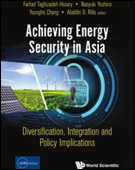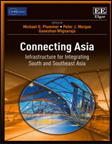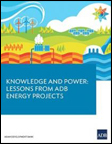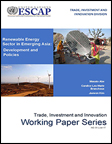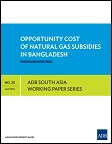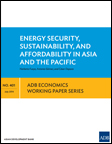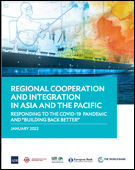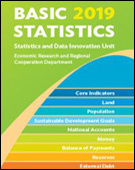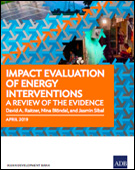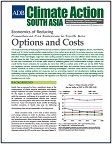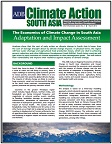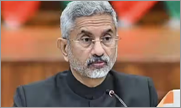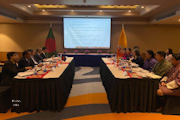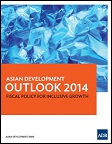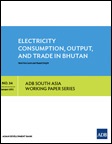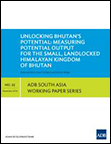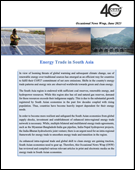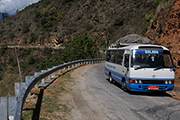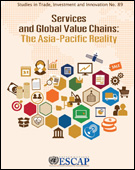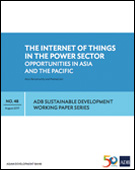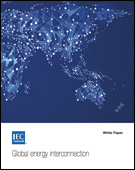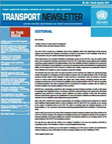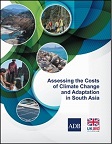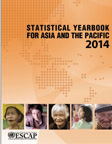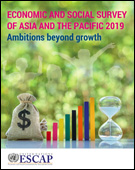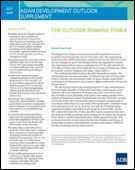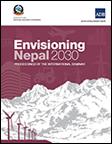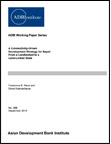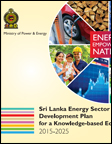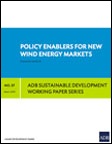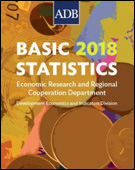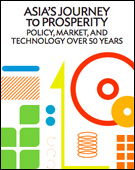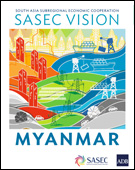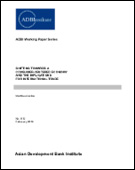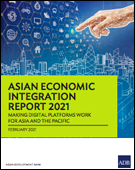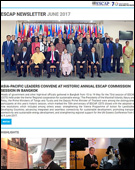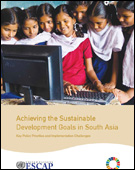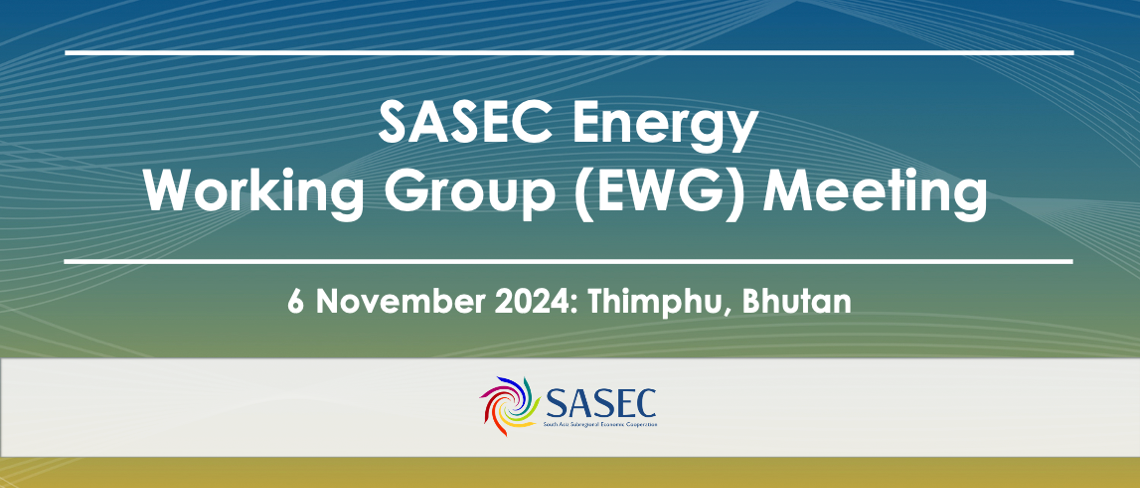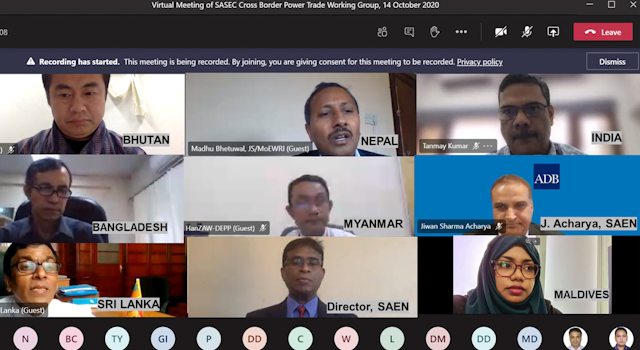Energy
Energy demand in the SASEC subregion is expected to increase over the next decade as a result of economic growth, rising per capita incomes, and energy consumption. With energy resources in South Asia unevenly distributed, regional energy cooperation will help countries develop their energy resources while lowering energy costs, improving regional energy security, and contributing to climate change mitigation. SASEC initiatives in the energy sector help develop energy trade infrastructure; strengthen the regional power market by harmonizing legal and regulatory frameworks; and create low-carbon alternatives, conservation and energy efficiency measures.
Search by Topic
Suggested Topics
PUBLICATIONS
showing 3 of 15 VIEW ALLThis publication reviews the status of energy security in Asia. In South Asia, countries face challenges in achieving energy security and climate goals. India and Bangladesh, for instance, face rising energy import bills while Maldives depends on oil products. The book suggests that countries and regions can achieve energy security through energy cooperation and diversification. This would lead to economic growth and poverty reduction, as well as mitigate energy security risks from climate change.
Source: Asian Development Bank Institute and World Scientific
This book contains background papers prepared for the Asian Development Bank and the Asian Development Bank Institute joint study, 'Connecting South Asia and Southeast Asia.' It emphasizes the potential contribution to growth that greater connectivity—through better transport and energy infrastructure and improved soft infrastructure, including trade facilitation—between South Asia and Southeast Asia can foster. With benefits including greater participation in global supply chains for South Asia; lower trade costs; and increase in inter- and intraregional trade, the book underscores that, at a juncture where closer regional integration can secure sustainable and inclusive growth for economies in the two regions, specific policies should be examined and considered to enable both regions to maximize gains from greater integration.
Source: Michael G. Plummer, Peter J. Morgan, Ganeshan Wignaraja, eds.
This publication highlights good practices and lessons learned from Asian Development Bank projects in energy, which comprised 26.5% of ADB's total lending commitments from 2008 to 2014. It discusses how the region's energy sources are utilized, providing updates on recent developments and challenges, highlighting the need for sustainable energy initiatives. Featured projects include the Green Power Development Project in Bhutan, which developed clean energy for regional use and promoted cross-border power trade. As the first infrastructure-focused public-private partnership in Bhutan, it also illustrated how projects can benefit with the active participation of the private sector, foreign parties, and commercial and public financial institutions. Also featured is the Bangladesh-India Electrical Grid Interconnection Project, which reduced Bangladesh's energy deficiency by enabling the country to affordably import 500 megawatts of electricity from India. This electrical link laid the groundwork for a regional energy market, an important step toward achieving a functioning regional electricity network in South Asia.
Source: Asian Development Bank
WORKING PAPER
showing 3 of 4 VIEW ALLRapid economic growth in emerging Asia has led to a critical increase of greenhouse gas emissions. Transitioning to renewable energy sources would help reduce emissions. However, massive investment is needed to make that transition. According to this paper, targeted policy interventions are needed to facilitate trade and investment in the renewable energy sector and create “green jobs” in the low-carbon and resource-efficient sectors.
This paper examines the impact of optimal gas pricing policy using a general equilibrium model for the Bangladesh economy. It estimates the opportunity cost of underpricing or subsidizing gas in Bangladesh. It further explores the potential impacts of an increase in investment on social and physical infrastructure using the social accounting matrix multiplier model. The results reveal that Bangladesh is losing a significant development opportunity due to its gas subsidy. Calculations using a dynamic computable general equilibrium model suggest that withdrawal of the gas subsidy along with increased investments in physical and social infrastructure would lead to positive macroeconomic and sectoral effects in Bangladesh.
Energy security, sustainability, and affordability from 2010 to 2035 for Asian Development Bank’s Asia and Pacific members are calculated in this working paper, including potential benefits of integrating energy systems regionally. Based on business-as-usual and alternative scenarios, outlook on SASEC member countries by 2035 include (i) dramatic improvement in Bhutan's energy efficiency, (ii) slight decrease in Bangladesh's energy intensity—although carbon dioxide will increase in its primary energy mix, as dependence on fossil fuels rise, and (iii) decrease in energy self-sufficiency of SASEC member countries by 2035, but improved energy affordability. Since renewable energy sources and importation of energy may be capital-intensive, requiring additional tariff support, regional cooperation can enhance affordability and energy security—with Bhutan and Nepal standing to benefit greatly from energy integration in South Asia.
REPORTS
showing 3 of 38 VIEW ALLPlatforms for regional and subregional cooperation helped spur collective action to help Asia and the Pacific build back resiliency from the coronavirus disease (COVID-19) pandemic. Regional cooperation platforms such as the South Asia Subregional Economic Cooperation program helped countries respond to the COVID-19 emergency. In South Asia, partners will have the opportunities to support regional market development through transport corridors, trade facilitation, and cross-border energy trade post-COVID-19.
Source: Asian Development Bank
Basic Statistics presents select economic, environmental, and social indicators used to track progress toward the Sustainable Development Goals. It includes indicators for development indicators for 46 economies in the Asia and Pacific region, including those for the seven SASEC countries: Bangladesh, Bhutan, India, Maldives, Myanmar, Nepal, and Sri Lanka.
Source: Asian Development Bank
Impact evaluations in the energy sector has so far focused on rural electrification and improved cookstoves. However, most investments have been in power generation and transmission. This energy sector impact evaluation report assesses what has been produced against what might be possible. It summarizes outcomes of 85 impact evaluations of energy interventions in developing countries, including Bangladesh, Bhutan, India, and Nepal. It looks at evidence gaps and proposes future directions for impact evaluations in the energy sector.
The study Economics of Reducing Greenhouse Gas Emissions: Options and Costs in Bangladesh, Bhutan, the Maldives, Nepal, and Sri Lanka reveals excellent opportunities in low-carbon green growth by pursuing resource- and energyefficient technologies that would lower emissions of greenhouse gases at low cost or even cost saving (benefits).
Source: Asian Development Bank
Analyses show that the cost of early action on climate change in South Asia is lower than the cost of damage brought about by climate change impacts. In physical terms, the region will face water shortage and agricultural food production losses, which are vital to achieving poverty reduction and other Millennium Development Goals (MDGs).
Source: Asian Development Bank
EVENT MATERIALS
showing 3 of 10 VIEW ALL2017-05-06, Yokohama, Japan
2016-11-21, Dhaka, Bangladesh
2014-05-03, Astana, Kazakhstan
NEWS & MULTIMEDIA
showing 3 of 98 VIEW ALLThe Bay of Bengal Initiative for Multi-Sectoral Technical and Economic Cooperation (BIMSTEC) Foreign Ministers' Retreat drew to a close on 11-12 July 2024, as foreign ministers gathered to strengthen cooperation among the BIMSTEC member countries. Mr. Subrahmanyam Jaishankar, India External Affairs Minister, lauded the retreat, describing it as "productive" and the meetings "highly useful."
The Cabinet Committee on Government Purchase in Bangladesh has approved a proposal to import 40 megawatts of electricity from Nepal. This marks a significant step in energy cooperation between Bangladesh and Nepal.
The governments of Bangaldesh and Bhutan reviewed bilateral relations and agreed to further strengthen cooperation in areas including trade, investment, energy, tourism, and connectivity at their Third Foreign Office Consultation.
PUBLICATIONS
showing 3 of 13 VIEW ALLThis publication highlights good practices and lessons learned from Asian Development Bank projects in energy, which comprised 26.5% of ADB's total lending commitments from 2008 to 2014. It discusses how the region's energy sources are utilized, providing updates on recent developments and challenges, highlighting the need for sustainable energy initiatives. Featured projects include the Green Power Development Project in Bhutan, which developed clean energy for regional use and promoted cross-border power trade. As the first infrastructure-focused public-private partnership in Bhutan, it also illustrated how projects can benefit with the active participation of the private sector, foreign parties, and commercial and public financial institutions. Also featured is the Bangladesh-India Electrical Grid Interconnection Project, which reduced Bangladesh's energy deficiency by enabling the country to affordably import 500 megawatts of electricity from India. This electrical link laid the groundwork for a regional energy market, an important step toward achieving a functioning regional electricity network in South Asia.
Source: Asian Development Bank
The Asian Development Outlook, ADB’s flagship economic publication provides comprehensive macroeconomic analysis in Asia including growth projections by country and region. The Asian Development Outlook 2014 forecasts that developing Asia will grow 6.2% in 2014 and 6.4% in 2015. South Asia remains one of the slowest growing subregions—although growth is forecast to improve by 5.3% in 2014 and 5.8% in 2015.
Source: Asian Development Bank
This publication reviews and documents experiences in transport investments and identifies opportunities to further mainstream climate risk management in transport investment projects. It also presents case studies where climate risk and vulnerability assessment were carried out and climate proofing measures have become an integral component of project design.
Source: Asian Development Bank
This ADB South Asia Working Paper examines the relationship between electricity consumption, international trade, and economic growth using an augmented production function framework. The findings show that Bhutan is energy-dependent and can promote economic growth through future investment in hydropower. More specifically, the results show that a 1% increase in (i) electricity consumption generates 0.03%-0.05% increase in output, (ii) total trade results in 0.5% increase in output, (iii) trade openness results in 1% increase in output.
Source: Hooi Hooi Lean and Russell Smyth
Energy security, sustainability, and affordability from 2010 to 2035 for Asian Development Bank’s Asia and Pacific members are calculated in this working paper, including potential benefits of integrating energy systems regionally. Based on business-as-usual and alternative scenarios, outlook on SASEC member countries by 2035 include (i) dramatic improvement in Bhutan's energy efficiency, (ii) slight decrease in Bangladesh's energy intensity—although carbon dioxide will increase in its primary energy mix, as dependence on fossil fuels rise, and (iii) decrease in energy self-sufficiency of SASEC member countries by 2035, but improved energy affordability. Since renewable energy sources and importation of energy may be capital-intensive, requiring additional tariff support, regional cooperation can enhance affordability and energy security—with Bhutan and Nepal standing to benefit greatly from energy integration in South Asia.
The hydropower sector has driven Bhutan's economic growth in the past two decades with growth rates averaging 7.9%. Yet, the economy has not been invulnerable to market fluctuations and external shocks. This ADB South Asia Working Paper analyzes how Bhutan can create sustainable and inclusive growth, alongside the continuous expansion of its hydropower industry. It examines how certain policies can impact Bhutan's potential growth over 2013–2030. Results show that higher investment in education, health, and efforts to diversify its economic base—including enhancement of new industries with linkages to regional and global value chains—can further drive economic growth and improve the country's living standards.
Source: Sabyasachi Mitra, Sarah Carrington, and Anthony Baluga
REPORTS
showing 3 of 30 VIEW ALLCountries are shifting to using green energy sources to meet their energy needs and cut emissions. While South Asia may have ample renewable energy and hydropower resources, demand exceeds local supply, and the countries have had to rely heavily on imports. To help improve energy security in the region, South Asian countries have signed bilateral and multilateral agreements to trade energy, including India-Nepal hydropower projects and the India-Bhutan hydroelectric joint venture.
Source: CUTS International
Basic Statistics presents select economic, environmental, and social indicators used to track progress toward the Sustainable Development Goals. It includes indicators for development indicators for 46 economies in the Asia and Pacific region, including those for the seven SASEC countries: Bangladesh, Bhutan, India, Maldives, Myanmar, Nepal, and Sri Lanka.
Source: Asian Development Bank
Impact evaluations in the energy sector has so far focused on rural electrification and improved cookstoves. However, most investments have been in power generation and transmission. This energy sector impact evaluation report assesses what has been produced against what might be possible. It summarizes outcomes of 85 impact evaluations of energy interventions in developing countries, including Bangladesh, Bhutan, India, and Nepal. It looks at evidence gaps and proposes future directions for impact evaluations in the energy sector.
The study Economics of Reducing Greenhouse Gas Emissions: Options and Costs in Bangladesh, Bhutan, the Maldives, Nepal, and Sri Lanka reveals excellent opportunities in low-carbon green growth by pursuing resource- and energyefficient technologies that would lower emissions of greenhouse gases at low cost or even cost saving (benefits).
Source: Asian Development Bank
Analyses show that the cost of early action on climate change in South Asia is lower than the cost of damage brought about by climate change impacts. In physical terms, the region will face water shortage and agricultural food production losses, which are vital to achieving poverty reduction and other Millennium Development Goals (MDGs).
Source: Asian Development Bank
EVENT MATERIALS
showing 3 of 12 VIEW ALL2017-05-06, Yokohama, Japan
2016-12-12, Thimphu, Bhutan
2016-10-26, Thimphu, Bhutan
NEWS & MULTIMEDIA
showing 3 of 71 VIEW ALLMr. Vikram Misri, Foreign Secretary of the Government of India to Bhutan, undertook an official visit to Bhutan in July 2024. During the Third India-Bhutan Development Cooperation Talks, both countries discussed the implementation of India's development support for Bhutan's 13th Five Year Plan. A key highlight of the talks was the approval of 61 projects covering a wide range of sectors.
The Bay of Bengal Initiative for Multi-Sectoral Technical and Economic Cooperation (BIMSTEC) Foreign Ministers' Retreat drew to a close on 11-12 July 2024, as foreign ministers gathered to strengthen cooperation among the BIMSTEC member countries. Mr. Subrahmanyam Jaishankar, India External Affairs Minister, lauded the retreat, describing it as "productive" and the meetings "highly useful."
Seven countries now generate nearly all their electricity from renewable energy sources, according to newly compiled figures by the International Energy Agency (IEA) and International Renewable Energy Agency (IRENA). Bhutan and Nepal produced more than 99.7% of their electricity using geothermal, hydro, solar, or wind power.
PUBLICATIONS
showing 3 of 20 VIEW ALLThis publication reviews the status of energy security in Asia. In South Asia, countries face challenges in achieving energy security and climate goals. India and Bangladesh, for instance, face rising energy import bills while Maldives depends on oil products. The book suggests that countries and regions can achieve energy security through energy cooperation and diversification. This would lead to economic growth and poverty reduction, as well as mitigate energy security risks from climate change.
Source: Asian Development Bank Institute and World Scientific
This book reviews issues concerning the roles of services in global value chains. It presents a framework for assessing links among different services and between services and the manufacturing sector. The book explains the contribution of services to global value chains in the Asia-Pacific region and to the world and also draws lessons with which countries could understand the importance of services and participation in global value chains to achieving sustainable development.
The Asian Development Bank (ADB), through its Climate Technology Finance Center, seeks to accelerate clean technology entrepreneurship and investment in Asia by supporting programs that aim to produce investable clean technology, risk capital for clean technology, technological knowledge, and a stronger clean technology ecosystem. This brochure gives a brief background on how ADB works with start-ups across Asia to promote more efficient management of energy and natural resources.
Source: Asian Development Bank
WORKING PAPER
showing 3 of 6 VIEW ALLAsia’s power sector struggles to upgrade power systems and keep up with growing demand. The Internet of Things (IoT) has the potential to transform the power sector by optimizing operations and lowering costs for consumers. The power sector is already reaping the benefits of adoption of smart meters and smart thermostats, two consumer-oriented IoT applications. The Asian Development Bank has committed to smart grid projects in India, through a Green Energy Corridor and Grid Strengthening Project, and Maldives, through the Preparing Outer Islands for Sustainable Energy Development (Phase 1).
Source: Arun Ramamurthy and Pramod Jain
Sustainable energy and climate change are major global concerns, yet three billion people around the world rely on wood, coal, or animal waste for cooking and heating. The interconnection of grids would open up opportunities for resource sharing and bring clean energy to much more of the world. This paper assesses benefits and outlines policy, technical, and economic preconditions for global energy interconnection. It analyzes global transmission scenarios and evaluates their impact on energy supplies and the environment. It also gives recommendations for setting standards, and where stakeholder involvement is necessary.
Rapid economic growth in emerging Asia has led to a critical increase of greenhouse gas emissions. Transitioning to renewable energy sources would help reduce emissions. However, massive investment is needed to make that transition. According to this paper, targeted policy interventions are needed to facilitate trade and investment in the renewable energy sector and create “green jobs” in the low-carbon and resource-efficient sectors.
REPORTS
showing 3 of 48 VIEW ALLCountries are shifting to using green energy sources to meet their energy needs and cut emissions. While South Asia may have ample renewable energy and hydropower resources, demand exceeds local supply, and the countries have had to rely heavily on imports. To help improve energy security in the region, South Asian countries have signed bilateral and multilateral agreements to trade energy, including India-Nepal hydropower projects and the India-Bhutan hydroelectric joint venture.
Source: CUTS International
Platforms for regional and subregional cooperation helped spur collective action to help Asia and the Pacific build back resiliency from the coronavirus disease (COVID-19) pandemic. Regional cooperation platforms such as the South Asia Subregional Economic Cooperation program helped countries respond to the COVID-19 emergency. In South Asia, partners will have the opportunities to support regional market development through transport corridors, trade facilitation, and cross-border energy trade post-COVID-19.
Source: Asian Development Bank
Impact evaluations in the energy sector has so far focused on rural electrification and improved cookstoves. However, most investments have been in power generation and transmission. This energy sector impact evaluation report assesses what has been produced against what might be possible. It summarizes outcomes of 85 impact evaluations of energy interventions in developing countries, including Bangladesh, Bhutan, India, and Nepal. It looks at evidence gaps and proposes future directions for impact evaluations in the energy sector.
This United Nations Conference on Trade and Development (UNCTAD) newsletter focuses on the development dimension and benefits of the World Trade Organization Trade Facilitation Agreement. It includes sections on the national trade facilitation committees, project proposal for the implementation of trade facilitation measures contained in the agreement, and improvement in implementation of sanitary and phytosanitary measures to facilitate trade. It also includes UNCTAD’s contribution to trade facilitation in Landlocked Developing Countries and Small Island Developing States.
Analyses show that the cost of early action on climate change in South Asia is lower than the cost of damage brought about by climate change impacts. In physical terms, the region will face water shortage and agricultural food production losses, which are vital to achieving poverty reduction and other Millennium Development Goals (MDGs).
Source: Asian Development Bank
EVENT MATERIALS
showing 3 of 17 VIEW ALL2017-10-12, Delhi, India
2017-05-06, Yokohama, Japan
2016-12-12, Thimphu, Bhutan
NEWS & MULTIMEDIA
showing 3 of 142 VIEW ALLIndia Prime Minister Narendra Modi and Sri Lanka President Anura Kumara Disanayaka held comprehensive discussions on 16 December 2024 in New Delhi, India. Both leaders affirmed their commitment to further enhance the relationship and emphasized cooperation in various areas, including connectivity, energy, trade, and tourism.
Mr. Vikram Misri, Foreign Secretary of the Government of India to Bhutan, undertook an official visit to Bhutan in July 2024. During the Third India-Bhutan Development Cooperation Talks, both countries discussed the implementation of India's development support for Bhutan's 13th Five Year Plan. A key highlight of the talks was the approval of 61 projects covering a wide range of sectors.
The Bay of Bengal Initiative for Multi-Sectoral Technical and Economic Cooperation (BIMSTEC) Foreign Ministers' Retreat drew to a close on 11-12 July 2024, as foreign ministers gathered to strengthen cooperation among the BIMSTEC member countries. Mr. Subrahmanyam Jaishankar, India External Affairs Minister, lauded the retreat, describing it as "productive" and the meetings "highly useful."
PUBLICATIONS
showing 3 of 10 VIEW ALLThis publication reviews the status of energy security in Asia. In South Asia, countries face challenges in achieving energy security and climate goals. India and Bangladesh, for instance, face rising energy import bills while Maldives depends on oil products. The book suggests that countries and regions can achieve energy security through energy cooperation and diversification. This would lead to economic growth and poverty reduction, as well as mitigate energy security risks from climate change.
Source: Asian Development Bank Institute and World Scientific
This book discusses the economic costs and benefits of unilateral and regional actors on climate change adaptation in Bangladesh, Bhutan, India, the Maldives, Nepal, and Sri Lanka. It provides the total economic loss throughout the 21st century and estimates the funding required for adaptation measures to avert potential losses. Huge impacts are likely on vulnerable sectors in the region, with South Asia losing on average nearly 2% of its gross domestic product by 2050. Results of the study will aid climate change adaptation in the region, including initiatives for regional cooperation.
The Statistical Yearbook contains comparative statistics and facts about the 58 regional members and associate members of the Economic and Social Commission for Asia and the Pacific. It includes brief analyses of 32 key development features such as energy supply and use, international trade, and transport, among others. In energy, the region’s production structure is highly resource-intensive, although per capita energy use is low. The section on international trade recommends focusing on raising domestic value-added rather than increasing gross exports in Asia and the Pacific. Finally, investment in environmentally sustainable transport is encouraged.
Source: United Nations Economic and Social Commission for Asia and the Pacific
Asia’s power sector struggles to upgrade power systems and keep up with growing demand. The Internet of Things (IoT) has the potential to transform the power sector by optimizing operations and lowering costs for consumers. The power sector is already reaping the benefits of adoption of smart meters and smart thermostats, two consumer-oriented IoT applications. The Asian Development Bank has committed to smart grid projects in India, through a Green Energy Corridor and Grid Strengthening Project, and Maldives, through the Preparing Outer Islands for Sustainable Energy Development (Phase 1).
Source: Arun Ramamurthy and Pramod Jain
REPORTS
showing 3 of 25 VIEW ALLThe Asia-Pacific region needs an estimated $1.5 trillion per year to end poverty and hunger, provide basic health care, quality education, enabling infrastructure, and clean energy for all, and for climate action and living in harmony with nature. Available public and private resources make these ambitions affordable for most countries in the region. However, development partnerships and regional cooperation are needed for all countries to achieve these “ambitions beyond growth.”
Source: United Nations Economic and Social Commission for Asia and the Pacific
Basic Statistics presents select economic, environmental, and social indicators used to track progress toward the Sustainable Development Goals. It includes indicators for development indicators for 46 economies in the Asia and Pacific region, including those for the seven SASEC countries: Bangladesh, Bhutan, India, Maldives, Myanmar, Nepal, and Sri Lanka.
Source: Asian Development Bank
South Asia continues to be the fastest expanding subregion, with growth on track to achieve forecasts of 7.0% in 2018 and 7.2% in 2019. India will meet April forecasts of 7.3% in 2018 and 7.6% in 2019. Owing to strong agricultural growth in Bangladesh and industry growth in Nepal, 2018 GDP growth in the two countries surpassed earlier forecasts. Decline in construction slowed Sri Lanka’s economic growth to 3.2% while hydropower production was lower than forecast in Bhutan. Cement, wood, and metal imports grew in Maldives.
Source: Asian Development Bank
The study Economics of Reducing Greenhouse Gas Emissions: Options and Costs in Bangladesh, Bhutan, the Maldives, Nepal, and Sri Lanka reveals excellent opportunities in low-carbon green growth by pursuing resource- and energyefficient technologies that would lower emissions of greenhouse gases at low cost or even cost saving (benefits).
Source: Asian Development Bank
Analyses show that the cost of early action on climate change in South Asia is lower than the cost of damage brought about by climate change impacts. In physical terms, the region will face water shortage and agricultural food production losses, which are vital to achieving poverty reduction and other Millennium Development Goals (MDGs).
Source: Asian Development Bank
EVENT MATERIALS
showing 3 of 6 VIEW ALL2017-05-06, Yokohama, Japan
2016-11-15, Male, Maldives
2014-11-05, Kathmandu, Nepal
NEWS & MULTIMEDIA
showing 3 of 9 VIEW ALLMr. R. K. Singh, Minister for Power and New and Renewable Energy of the Government of India, and Ms. Aminath Shauna, Minister of Environment, Climate Change and Technology of the Government of Maldives held discussions on establishing transmission interconnection for renewable power transfer. Their meeting proposed signing two MoUs: (i) energy cooperation, and (ii) transmission interconnection.
An Asian Development Bank report suggests that a shift in India’s electricity policy could help address the acute electricity shortages faced by SAARC countries, which affects socioeconomic development as well as business operations. Policy amendments could help facilitate cross-border power trade among SAARC countries and give communities better access to electricity.
Finance ministers and senior officials of member countries of the South Asian Association for Regional Cooperation (SAARC), including Afghanistan, Bangladesh, Bhutan, India, Maldives, Nepal, Pakistan, and Sri Lanka met on 5 May at Yokohama, Japan, at the sidelines of the Asian Development Bank (ADB) 50th Annual General Meeting.
PUBLICATIONS
showing 3 of 14 VIEW ALLThis book applies methodologies for assessing competitiveness of countries’ services sector. It examines the types of barriers to services in the regulatory environment and identifies the policy implications. It aims to guide policymakers in the area of services in international trade. The chapter on diversifying Nepal’s economy assesses the country’s trade potential in services. Using the Services Trade Competitiveness Diagnostic toolkit, it identifies policy measures that can help Nepal identify strategies for greater integration in the global marketplace.
This book reviews issues concerning the roles of services in global value chains. It presents a framework for assessing links among different services and between services and the manufacturing sector. The book explains the contribution of services to global value chains in the Asia-Pacific region and to the world and also draws lessons with which countries could understand the importance of services and participation in global value chains to achieving sustainable development.
Nepal's National Planning Commission has undertaken the initiative to develop Nepal’s long term Development Strategy 2030 by engaging with international development experts, development partners, policy makers, and representatives of civil society organizations in the international seminar 'Envisioning Nepal 2030'. With the aim of serving as a guideline for Nepal’s graduation from Least Developed Country status by 2022, achieve the Sustainable Development Goals in the post-Millennium Development Goals era, and become a middle-income country by 2030, the seminar identified challenges and opportunities, and discussed how a fast-paced and sustainable inclusive growth could be achieved. In his opening remarks, Asian Development Bank Vice President Wencai Zhang, underscored the importance for Nepal to strategically position itself within a broader regional cooperation to transform itself from a landlocked into a landlinked country.
WORKING PAPER
showing 3 of 4 VIEW ALLSustainable energy and climate change are major global concerns, yet three billion people around the world rely on wood, coal, or animal waste for cooking and heating. The interconnection of grids would open up opportunities for resource sharing and bring clean energy to much more of the world. This paper assesses benefits and outlines policy, technical, and economic preconditions for global energy interconnection. It analyzes global transmission scenarios and evaluates their impact on energy supplies and the environment. It also gives recommendations for setting standards, and where stakeholder involvement is necessary.
Energy security, sustainability, and affordability from 2010 to 2035 for Asian Development Bank’s Asia and Pacific members are calculated in this working paper, including potential benefits of integrating energy systems regionally. Based on business-as-usual and alternative scenarios, outlook on SASEC member countries by 2035 include (i) dramatic improvement in Bhutan's energy efficiency, (ii) slight decrease in Bangladesh's energy intensity—although carbon dioxide will increase in its primary energy mix, as dependence on fossil fuels rise, and (iii) decrease in energy self-sufficiency of SASEC member countries by 2035, but improved energy affordability. Since renewable energy sources and importation of energy may be capital-intensive, requiring additional tariff support, regional cooperation can enhance affordability and energy security—with Bhutan and Nepal standing to benefit greatly from energy integration in South Asia.
Transforming Nepal from a landlocked into a land-linked state, the authors argue, could be key to unlocking the country's much-awaited growth. With its strategic location between India and the People's Republic of China, a connectivity-driven development strategy could energize Nepal's lackluster post-conflict economic performance. Further, Nepal implements a multi-track approach to promoting regional cooperation and integration in connectivity with its neighbors, reinforced through participation in South Asian Association for Regional Cooperation, Bay of Bengal Initiative for Multi-Sectoral Technical and Economic Cooperation, and South Asia Subregional Economic Cooperation. By identifying ten priority projects that could further boost Nepal's connectivity, the paper also discusses how strengthening Nepal's transport, energy, and trade links could benefit the region. However, the authors also warn against “internal threats” to Nepal's development—corruption and the country's difficult political situation.
REPORTS
showing 3 of 38 VIEW ALLCountries are shifting to using green energy sources to meet their energy needs and cut emissions. While South Asia may have ample renewable energy and hydropower resources, demand exceeds local supply, and the countries have had to rely heavily on imports. To help improve energy security in the region, South Asian countries have signed bilateral and multilateral agreements to trade energy, including India-Nepal hydropower projects and the India-Bhutan hydroelectric joint venture.
Source: CUTS International
Impact evaluations in the energy sector has so far focused on rural electrification and improved cookstoves. However, most investments have been in power generation and transmission. This energy sector impact evaluation report assesses what has been produced against what might be possible. It summarizes outcomes of 85 impact evaluations of energy interventions in developing countries, including Bangladesh, Bhutan, India, and Nepal. It looks at evidence gaps and proposes future directions for impact evaluations in the energy sector.
Basic Statistics presents select economic, environmental, and social indicators used to track progress toward the Sustainable Development Goals. It includes indicators for development indicators for 46 economies in the Asia and Pacific region, including those for the seven SASEC countries: Bangladesh, Bhutan, India, Maldives, Myanmar, Nepal, and Sri Lanka.
Source: Asian Development Bank
The study Economics of Reducing Greenhouse Gas Emissions: Options and Costs in Bangladesh, Bhutan, the Maldives, Nepal, and Sri Lanka reveals excellent opportunities in low-carbon green growth by pursuing resource- and energyefficient technologies that would lower emissions of greenhouse gases at low cost or even cost saving (benefits).
Source: Asian Development Bank
Analyses show that the cost of early action on climate change in South Asia is lower than the cost of damage brought about by climate change impacts. In physical terms, the region will face water shortage and agricultural food production losses, which are vital to achieving poverty reduction and other Millennium Development Goals (MDGs).
Source: Asian Development Bank
EVENT MATERIALS
showing 3 of 10 VIEW ALL2017-05-06, Yokohama, Japan
2016-11-07, Kathmandu, Nepal
2014-11-05, Kathmandu, Nepal
NEWS & MULTIMEDIA
showing 3 of 126 VIEW ALLThe Bay of Bengal Initiative for Multi-Sectoral Technical and Economic Cooperation (BIMSTEC) Foreign Ministers' Retreat drew to a close on 11-12 July 2024, as foreign ministers gathered to strengthen cooperation among the BIMSTEC member countries. Mr. Subrahmanyam Jaishankar, India External Affairs Minister, lauded the retreat, describing it as "productive" and the meetings "highly useful."
The Cabinet Committee on Government Purchase in Bangladesh has approved a proposal to import 40 megawatts of electricity from Nepal. This marks a significant step in energy cooperation between Bangladesh and Nepal.
Seven countries now generate nearly all their electricity from renewable energy sources, according to newly compiled figures by the International Energy Agency (IEA) and International Renewable Energy Agency (IRENA). Bhutan and Nepal produced more than 99.7% of their electricity using geothermal, hydro, solar, or wind power.
PUBLICATIONS
showing 3 of 15 VIEW ALLThis book reviews issues concerning the roles of services in global value chains. It presents a framework for assessing links among different services and between services and the manufacturing sector. The book explains the contribution of services to global value chains in the Asia-Pacific region and to the world and also draws lessons with which countries could understand the importance of services and participation in global value chains to achieving sustainable development.
This book contains background papers prepared for the Asian Development Bank and the Asian Development Bank Institute joint study, 'Connecting South Asia and Southeast Asia.' It emphasizes the potential contribution to growth that greater connectivity—through better transport and energy infrastructure and improved soft infrastructure, including trade facilitation—between South Asia and Southeast Asia can foster. With benefits including greater participation in global supply chains for South Asia; lower trade costs; and increase in inter- and intraregional trade, the book underscores that, at a juncture where closer regional integration can secure sustainable and inclusive growth for economies in the two regions, specific policies should be examined and considered to enable both regions to maximize gains from greater integration.
Source: Michael G. Plummer, Peter J. Morgan, Ganeshan Wignaraja, eds.
Sri Lanka has set an set an ambitious goal of 100% energy self-sufficiency by 2030. With annual total electricity demand estimated at 10,500 gigawatt hours—increasing annually by around 4-6%—and challenges including high cost of electricity, 100% dependence on imported oil for the transport sector, and need for large investments in infrastructure, this book unveils how the energy sector plans to achieve energy security in the next 10 years—envisioning a future where clean, reliable, affordable energy is made available 24/7 to the whole country. This sector development plan for a knowledge-based economy aims to provide a balance between the country's energy demand and supply, and its long-term perspective anchored on continuous economic growth, through renewable and indigenous sources of energy.
This publication focuses on the wind energy policies that can support sustained development of wind power in emerging wind energy markets. The policies are based on the work done by Quantum Leap in Wind Power Development in Asia and the Pacific (QLW). QLW is a $2 million, 3-year project funded by the Asian Development Bank, to facilitate wind power sector development in developing countries. The success and failures of wind energy policies in Mongolia, the Philippines, and Sri Lanka – including its impact and evolution – are analyzed in this report.
Source: Pramod Jain and Bo An
This Asian Development Bank Institute paper examines trade and the main ports around the Bay of Bengal to identify projects that will enable trade and contribute to improved maritime infrastructure. It also reviews the nature of trade and trade patterns, particularly through the Indian East Coast Corridor study. The paper develops further strategic options for seaport adjustment around the Bay of Bengal to support trade evolution, policy assessment, and other constraints.
Source: David Wignall, Mark Wignall
REPORTS
showing 3 of 29 VIEW ALLBasic Statistics presents select economic, environmental, and social indicators used to track progress toward the Sustainable Development Goals. It includes indicators for development indicators for 46 economies in the Asia and Pacific region, including those for the seven SASEC countries: Bangladesh, Bhutan, India, Maldives, Myanmar, Nepal, and Sri Lanka.
Source: Asian Development Bank
The Asia-Pacific region needs an estimated $1.5 trillion per year to end poverty and hunger, provide basic health care, quality education, enabling infrastructure, and clean energy for all, and for climate action and living in harmony with nature. Available public and private resources make these ambitions affordable for most countries in the region. However, development partnerships and regional cooperation are needed for all countries to achieve these “ambitions beyond growth.”
Source: United Nations Economic and Social Commission for Asia and the Pacific
Basic Statistics presents development indicators for 45 economies in the Asia and Pacific region, including those for the seven SASEC countries, Bangladesh, Bhutan, India, Maldives, Myanmar, Nepal, and Sri Lanka. It presents selected core indicators such as international and national poverty rates, inflation, and current account balance. It also presents information on indicators related to land, population, sustainable development goals, national accounts, money, balance of payments, reserves, external debt, and central government finance.
Source: Asian Development Bank
The study Economics of Reducing Greenhouse Gas Emissions: Options and Costs in Bangladesh, Bhutan, the Maldives, Nepal, and Sri Lanka reveals excellent opportunities in low-carbon green growth by pursuing resource- and energyefficient technologies that would lower emissions of greenhouse gases at low cost or even cost saving (benefits).
Source: Asian Development Bank
EVENT MATERIALS
showing 3 of 7 VIEW ALL2017-05-06, Yokohama, Japan
2016-11-18, Colombo, Sri Lanka
2014-05-03, Astana, Kazakhstan
NEWS & MULTIMEDIA
showing 3 of 24 VIEW ALLIndia Prime Minister Narendra Modi and Sri Lanka President Anura Kumara Disanayaka held comprehensive discussions on 16 December 2024 in New Delhi, India. Both leaders affirmed their commitment to further enhance the relationship and emphasized cooperation in various areas, including connectivity, energy, trade, and tourism.
The Bay of Bengal Initiative for Multi-Sectoral Technical and Economic Cooperation (BIMSTEC) Foreign Ministers' Retreat drew to a close on 11-12 July 2024, as foreign ministers gathered to strengthen cooperation among the BIMSTEC member countries. Mr. Subrahmanyam Jaishankar, India External Affairs Minister, lauded the retreat, describing it as "productive" and the meetings "highly useful."
A memorandum of understanding on linking India and Sri Lanka’s electricity grids could soon be signed to be followed by a feasibility study, according to Mr. Milinda Moragoda, Sri Lankan High Commissioner to India. India and Sri Lanka revived talks on linking their electricity grids in the first quarter of 2022.
PUBLICATIONS
showing 3 of 36 VIEW ALLThis book presents factors that can explain Asia's development performance. It looks at the role of policy, market, and technology in promoting trade and investment, infrastructure, and regional cooperation and integration (RCI). In South Asia, RCI has focused on connectivity through transport, energy, and trade facilitation. The Asian Development Bank has supported RCI by initiating several subregional programs, such as the Greater Mekong Subregion (GMS), the Central Asia Regional Economic Cooperation (CAREC), and the South Asia Subregional Economic Cooperation (SASEC).
Source: Asian Development Bank
Myanmar serves as a land bridge between South Asia, Southeast Asia, and East Asia. This book identifies regional and subregional opportunities for Myanmar to harness natural and human resources, industrial potential, and infrastructure connectivity as part of the South Asia Subregional Economic Cooperation (SASEC) program. SASEC Vision – Myanmar serves to supplement the 2017 SASEC Vision document, which articulates shared aspirations of the SASEC countries and sets the path to achieve these through regional collaboration.
This book applies methodologies for assessing competitiveness of countries’ services sector. It examines the types of barriers to services in the regulatory environment and identifies the policy implications. It aims to guide policymakers in the area of services in international trade. The chapter on diversifying Nepal’s economy assesses the country’s trade potential in services. Using the Services Trade Competitiveness Diagnostic toolkit, it identifies policy measures that can help Nepal identify strategies for greater integration in the global marketplace.
WORKING PAPER
showing 3 of 17 VIEW ALLThis paper asserts that advances in information technology have allowed companies to know more about individual consumers. This has challenged theories that assume consumers to be identical, where goods and services that enter regional value chains are slow to respond to changing demands. The paper predicts that countries and firms will succeed depending on how they will integrate consumer information into the process of value addition.
Source: Matthias Helble
Asia’s power sector struggles to upgrade power systems and keep up with growing demand. The Internet of Things (IoT) has the potential to transform the power sector by optimizing operations and lowering costs for consumers. The power sector is already reaping the benefits of adoption of smart meters and smart thermostats, two consumer-oriented IoT applications. The Asian Development Bank has committed to smart grid projects in India, through a Green Energy Corridor and Grid Strengthening Project, and Maldives, through the Preparing Outer Islands for Sustainable Energy Development (Phase 1).
Source: Arun Ramamurthy and Pramod Jain
Rapid economic growth in emerging Asia has led to a critical increase of greenhouse gas emissions. Transitioning to renewable energy sources would help reduce emissions. However, massive investment is needed to make that transition. According to this paper, targeted policy interventions are needed to facilitate trade and investment in the renewable energy sector and create “green jobs” in the low-carbon and resource-efficient sectors.
REPORTS
showing 3 of 76 VIEW ALLCountries are shifting to using green energy sources to meet their energy needs and cut emissions. While South Asia may have ample renewable energy and hydropower resources, demand exceeds local supply, and the countries have had to rely heavily on imports. To help improve energy security in the region, South Asian countries have signed bilateral and multilateral agreements to trade energy, including India-Nepal hydropower projects and the India-Bhutan hydroelectric joint venture.
Source: CUTS International
Platforms for regional and subregional cooperation helped spur collective action to help Asia and the Pacific build back resiliency from the coronavirus disease (COVID-19) pandemic. Regional cooperation platforms such as the South Asia Subregional Economic Cooperation program helped countries respond to the COVID-19 emergency. In South Asia, partners will have the opportunities to support regional market development through transport corridors, trade facilitation, and cross-border energy trade post-COVID-19.
Source: Asian Development Bank
This report reviews economic cooperation and integration in Asia and the Pacific. As of the end of 2019, ADB had committed a total of $13.77 billion to 60 projects under the South Asia Subregional Economic Cooperation (SASEC) partnership, including projects for improving transport connectivity, trade facilitation, and power transmission. In 2019, SASEC members revamped the SASEC Operational Plan 2016–2025 to prioritize narrowing gaps in the subregion’s transport and energy networks. The SASEC program focused on expanding multimodal connectivity to include maritime and inland water transport. Subregional health cooperation was strengthened in 2020 to improve access to health services in Asia and the Pacific.
Source: Asian Development Bank
PERIODICALS
showing 3 of 5 VIEW ALLThe ESCAP Newsletter is a monthly recap of the key events, publications and other activities of the United Nations Economic and Social Commission for Asia and the Pacific (UNESCAP). It highlights the key issues that the UNESCAP works on and how the organization works to support member states in reaching the objectives of the Sustainable Development Goals (SDGs). This issue highlights the 73rd Commission Session of Asia-Pacific leaders on "Regional Cooperation for Sustainable Energy," which culminated with the adoption of resolutions advancing transport connectivity and sustainable energy development.
Source: United Nations Economic and Social Commission for Asia and the Pacific
South Asia needs to address development gaps in terms of transport infrastructure, energy, and basic services. The 2030 Agenda for Sustainable Development and its 17 Sustainable Development Goals (SDGs), if pursued decisively, could transform South Asia by bridging these gaps and addressing economic, social and environmental challenges in the region. This report offers tangible means to mainstream the SDGs through national development plans and programs. It outlines seven key policies that could create conditions for sustainable prosperity through regional cooperation and other strategies and demonstrates how a sustainable industrialization strategy could generate 56 million new jobs in South Asia by 2030.
Source: United Nations Economic and Social Commission for Asia and the Pacific
This United Nations Conference on Trade and Development (UNCTAD) newsletter focuses on the development dimension and benefits of the World Trade Organization Trade Facilitation Agreement. It includes sections on the national trade facilitation committees, project proposal for the implementation of trade facilitation measures contained in the agreement, and improvement in implementation of sanitary and phytosanitary measures to facilitate trade. It also includes UNCTAD’s contribution to trade facilitation in Landlocked Developing Countries and Small Island Developing States.
EVENT MATERIALS
showing 3 of 29 VIEW ALL2024-11-06, Thimphu, Bhutan
2020-10-14, Online
2019-06-24, Kathmandu, Nepal
NEWS & MULTIMEDIA
showing 3 of 256 VIEW ALLIndia Prime Minister Narendra Modi and Sri Lanka President Anura Kumara Disanayaka held comprehensive discussions on 16 December 2024 in New Delhi, India. Both leaders affirmed their commitment to further enhance the relationship and emphasized cooperation in various areas, including connectivity, energy, trade, and tourism.
Mr. Vikram Misri, Foreign Secretary of the Government of India to Bhutan, undertook an official visit to Bhutan in July 2024. During the Third India-Bhutan Development Cooperation Talks, both countries discussed the implementation of India's development support for Bhutan's 13th Five Year Plan. A key highlight of the talks was the approval of 61 projects covering a wide range of sectors.
The Bay of Bengal Initiative for Multi-Sectoral Technical and Economic Cooperation (BIMSTEC) Foreign Ministers' Retreat drew to a close on 11-12 July 2024, as foreign ministers gathered to strengthen cooperation among the BIMSTEC member countries. Mr. Subrahmanyam Jaishankar, India External Affairs Minister, lauded the retreat, describing it as "productive" and the meetings "highly useful."

